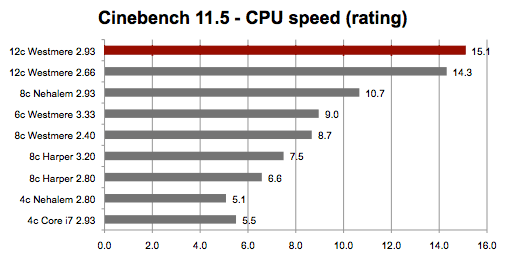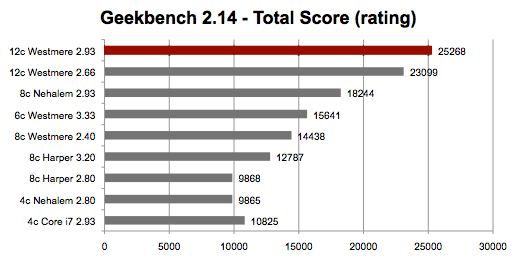EARLY BENCHMARKS:
2010 Mac Pro versus others
Posted Sunday, August 22nd, 2010, by rob-ART morgan, mad scientist
Updated August 23rd, with 12 core 2.93 results
With the help of remote mad scientists, I have some early benchmark results for the 2010 Mac Pro versus the 2009 and 2008 Mac Pro. Much more is coming but consider this an appetizer.


LEGEND
12c Westmere 2.93 = 12-core Westmere 2.93GHz Mac Pro (2010)
12c Westmere 2.66 = 12-core Westmere 2.66GHz Mac Pro (2010)
8c Nehalem 2.93 = 8-core Nehalem 2.93GHz Mac Pro (2009)
6c Westmere 3.33 = 6-core Westmere 3.33GHz Mac Pro (2010)
8c Westmere 2.40 = 8-core Westmere 2.4GHz Mac Pro (2010)
8c Harper 3.20 = 8-core Harpertown 3.2GHz Mac Pro (2008)
8c Harper 2.80 = 8-core Harpertown 2.8GHz Mac Pro (2008)
4c Nehalem 2.80 = 4-core Nehalem 2.8GHz Mac Pro (2010)
4c Core i7 2.93 = 4-core Core i7 2.93GHz iMac (2010)
WHAT HAVE WE LEARNED SO FAR?
Firstly, don't jump to unwarranted conclusions. Although the 12-core Mac Pros score best, these benchmark apps use all cores to full advantage. In the real world, only certain apps are capable of using all cores. More often than not, these apps use them inefficiently or run faster if you limit the number of active cores. I'm speaking of apps like After Effects CS5 and Compressor 3.5.
There are other MP aware apps like Photoshop, iMovie, and Aperture which only use a portion of the cores no matter how many real or virtual cores there may be. There are yet others (such as Motion and iTunes) that only use one core, though Motion uses the GPU as a co-processor.
In defense of 12-core Mac Pros, as applications are improved to utilize their full potential, they will justify their existence more strongly.
We will be posting test results for all real world apps in the days to come. Meanwhile, I encourage you to check out Lloyd Chambers' posting of his comparison between the 6-core Westmere and three other Macs using Photoshop, After Effects, memory bandwidth tests, and more.
Secondly, many of you are trying to decide between the 6-core 3.33 and the 8-core 2.4. Based on the graphs above, the 6-core has the edge in speed. The 8-core has the edge on number of memory slots, though.
Thirdly, note that last year's 8-core Nehalem 2.93 beats this year's 6-core and 8-core Mac Pro. Only the 12-core models are faster running Cinebench and Geekbench. So if you have a 2009 8-core, you may want to hang onto it and upgrade the graphics card with a Radeon HD 5770 or 5870 kit. If you can't afford one of the 2010 Mac Pros, maybe you can get a deal on a used or refurb 2009 Mac Pro 8-core.
MORE TO COME
The only 2010 Mac Pro we currently have in the lab is the 6-core. The rest of the 2010 Mac Pro numbers you see in the graphs are from our Remote Mad Scientists (RMS).
We have real world app results rolling in by the hour -- including 3G games, so stay tuned. Together, we can create a good cross section of test results on the six variations of 2010 Mac Pro. Have comments? Want to volunteer to test? Contact me
, mad scientist.
WHERE TO BUY APPLE PRODUCTS
When you purchase products at Apple USA, please CLICK THIS LINK or any APPLE BANNERS at the top of our pages. It's a great way to support Bare Feats since we earn a commission on each click-through that results in a sale.